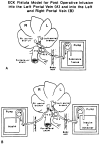Screening for candidate hepatic growth factors by selective portal infusion after canine Eck's fistula
- PMID: 1916668
- PMCID: PMC2975974
- DOI: 10.1016/0270-9139(91)90055-z
Screening for candidate hepatic growth factors by selective portal infusion after canine Eck's fistula
Abstract
Completely diverting portacaval shunt (Eck's fistula) in dogs causes hepatocyte atrophy, disruption of hepatocyte organelles, fatty infiltration and low-grade hyperplasia. The effect of hepatic growth regulatory substances on these changes was assessed by constantly infusing test substances for four postoperative days after Eck's fistula into the detached left protal vein above the shunt. The directly infused left lobes were compared histopathologically with the untreated right lobes. In what has been called an hepatotrophic effect, stimulatory substances prevented the atrophy and increased hepatocyte mitoses. Of the hormones tested, only insulin was strongly hepatotrophic; T3 had a minor effect, and glucagon, prolactin, angiotensin II, vasopressin, norepinephrine and estradiol were inert. Insulin-like growth factor, hepatic stimulatory substance, transforming growth factor-alpha and hepatocyte growth factor (also known as hematopoietin A) were powerfully hepatotrophic, but epidermal growth factor had a barely discernible effect. Transforming growth factor-beta was inhibitory, but tamoxifen, interleukin-1 and interleukin-2 had no effect. The hepatotrophic action of insulin was not altered when the insulin infusate was mixed with transforming growth factor-beta or tamoxifen. These experiments show the importance of in vivo in addition to in vitro testing of putative growth control factors. They illustrate how Eck's fistula model can be used to screen for such substances and possibly to help delineate their mechanisms of action.
Figures
References
-
- Short J, Brown RF, Husakova JR, Gilbertson JR, Zemel R, Lieberman I. Induction of DNA synthesis in the liver of the intact animal. J Bioi Chem. 1972;47:1757–1763. - PubMed
-
- Starzl TE, Porter KA, Putnam CW. Intraportal insulin protects from the liver injury of portacaval shunt in dogs. Lancet. 1975;2:1241–1246. - PubMed
-
- Starzl TE, Watanabe K, Porter KA, Putnam CW. Effect of insulin, glucagon, and insulin/glucagon infusion on liver morphology and cell division after complete portacaval shunt in dogs. Lancet. 1976;1:821–825. - PubMed
-
- Bucher NLR, McGowan JA, Patel U. Hormonal regulation of liver growth. In: Dirksen ER, Prescott DM, Fox CF, editors. Cell reproduction: ICN/UCLA symposium on molecular cell biology. Vol 12. Academic Press; New York: 1978. pp. 661–670.
Publication types
MeSH terms
Substances
Grants and funding
LinkOut - more resources
Full Text Sources
Other Literature Sources
Miscellaneous

